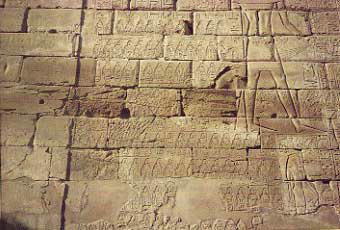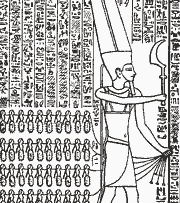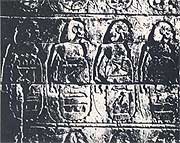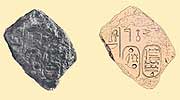Excerpted from "Does the Bible Exaggerate King Solomon's Golden Wealth?"
Editor, H. S. (2002;2002). BAR 15:03 (May/June 1989). Biblical Archaeology Society.
Shishak's Military Campaign in Israel Confirmed By Kenneth A. Kitchen

© Kenneth A. Kitchen
Triumphal relief of Pharaoh Shishak.
In the previous sidebar, I quote the reference in 1 Kings to Pharaoh Shishak's attack on Jerusalem shortly after Solomon's death. A similar passage can be found in Chronicles:
"Shishak king of Egypt attacked Jerusalem in the fifth year of king Rehoboam. With 1200 chariots and 60,000 horsemen and the innumerable troops of Libyans, Sukkites and Cushites that came with him from Egypt, he captured the fortified cities of Judah and came as far as Jerusalem" ( 2 Chronicles 12:2-4 ).
Unfortunately, no single Egyptian document gives us a narrative equivalent to that found in Kings and Chronicles. At the Karnak temple of the god Amun in Thebes, however, Shishak (Shoshenq I) left a vast triumphal relief–possibly unfinished–to celebrate his military campaign that brought to Egypt loot from Solomon's Temple. The Amun temple relief lists many towns in Palestine and gives both more and less information about this Egyptian military campaign than do the Biblical accounts. Damage to several sections of the hieroglyphic list regrettably robs us of the mention of a number of place-names, particularly in Judah, while, on the other hand, the list includes many places in Israel, showing that Shishak also brought Jeroboam, king of Israel, to heel, a point that did not interest the Jerusalem-based Biblical annalists.

Drawing of the triumphal relief of Pharaoh Shishak. |
The relief includes rows of heads with hieroglyph-fitted ovals for bodies which name many places in Judah and Israel. A drawing (above) and a photo (below) show details of Shoshenq's relief. The four ovals in the photo detail appear just below and to the left of Shoshenq's right foot (see tinted area in drawing). These four ovals contain the names of three places in the Negev: The one on the right reads 'irhrr, which may be Jehallel, mentioned in 1 Chronicles 4:16 ; the two in the middle read p._qr 'ibrm "Fort of Abram" (?); and the one at left reads _brt , "Shibboleth," which means stream. No narrative, however, accompanies this hieroglyphic list.
One smashed stela from Karnak does preserve a few phrases about the start of Shishak's campaign:

Detail of the triumphal relief of Pharaoh Shishak, depicting heads with hieroglyphic-filled ovals for bodies. The four ovals shown here contain the name of four places in the Negev. |
"Now, My Majesty found that [ ... they] were killing [ ... ] army-leaders. His Majesty was upset about them [His Majesty went forth,] his chariotry accompanying him without (the enemy's) knowing it. His Majesty made great slaughter among them, at the edge of the Bitter Lakes." A contemporary, Hori, had been a "real royal scribe, [following] the king at his incursions into the foreign lands of Retenu [i.e., Palestine]".
Finally, physical proof of the presence of Shishak in Palestine is afforded by the corner-fragment of a once great stela found at Megiddo in Israel. Excavators of Megiddo in the 1920s and '30s unearthed a 15-inch-long stone fragment with carved cartouches1 of the king. The fragment dates to about 925 B.C. Seen clearly in the drawing, Shishak's cartouches read:
Hedj-kheper-Re "Bright is the form of (the sun-god) Re"
"Amun's beloved, Shoshenq (I)."

The Oriental Institute, Univ. of Chicago
Fragment of a stela found at Megiddo, inscribed with cartouches of Pharaoh Shishak. |
1 A cartouche is the oval outline (horizontal or vertical), with a cross-tie at the end, within which a pharaoh usually inscribed the hieroglyphs of either of his two most important names: his throne-name and his personal name.
 
|
|